To contribute to creating a low-carbon society through the stable supply of high-quality, low-cost electricity, TEPCO promotes the best mix of power sources composed of nuclear power, a primary source of electricity provides excellent "environmental performance", "stability" and "economic efficiency", and a good balance of thermal power and renewable energies. Ongoing efforts are also made to increase the efficiency of power facilities such as increase thermal power generation efficiency.
CO2 emissions, emission intensity, and electricity sales
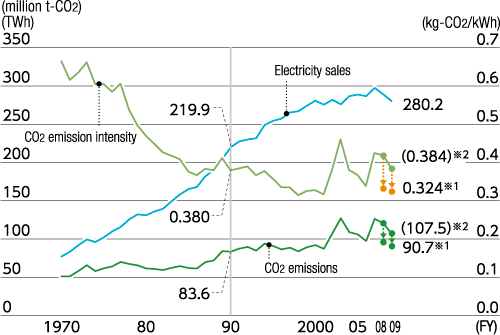 *1 Values reflecting carbon credits.
*1 Values reflecting carbon credits.
*2 Values without carbon credits.
(Note) TEPCO’s CO2 emission intensity is calculated based on the “greenhouse gas emissions calculation, reporting, and disclosure system” stipulated by the Law Concerning the Promotion of Measures to Cope with Global Warming. Note that the system does not take into account CO2 reduction values achieved through the Green Power Certification System or other such mechanisms.
Lifecycle CO2 emissions for different types of power
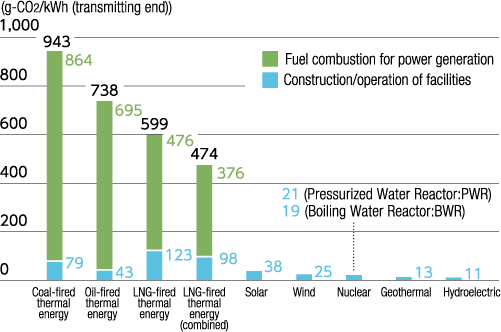
(Note 1) Figures may not sum to the total, due to rounding.
(Note 2) The above figures include CO2 emitted in the process of burning fuel to generate power, as well as CO2 emissions from all energy uses, such as for the extraction of raw materials, construction of power generating facilities, fuel transportation and refining, and plant operation and maintenance. CO2 emissions from nuclear power include emissions from domestic reprocessing of spent fuels that is currently being planned, the utilization of plutonium-thermal energy (on the assumption that it is recycled once), and from the disposal of high-level radioactive waste.Source: Central Research Institute of Electric Power Industry, “Evaluation of Life Cycle CO2 Emissions of Power Generation Technologies”
Nuclear power generation is a highly effective countermeasure to global warming, as it does not emit CO2 in the power generation process. Based on the premise of ensuring safety and security, we are aiming to expand nuclear power use by increasing the facility utilization rates of nuclear power station and developing new power sources.
TEPCO's CO2 emissions increased drastically in FY2007 and FY2008 as a result of the prolonged shutdown of the Kashiwazaki-Kariwa Nuclear Power Station after sustaining damage from the Niigata-Chuetsu-Oki Earthquake in July 2007. In FY2009, however, nuclear facility utilization rate increased approximately 10 points from FY2008 to 53.3% as a result of the recommissioning of Units 6 and 7 at the Kashiwazaki-Kariwa Nuclear Power Station, and CO2 emissions dropped by approximately 11% to 107.5 million tons.
The operational status of nuclear power stations clearly has a large effect on CO2 emissions. Hypothetically speaking, each 1% increase in facility utilization rate at TEPCO's nuclear power stations would reduce yearly CO2 emissions by approximately a million tons.
Nuclear facility utilization rate and CO2 emissions
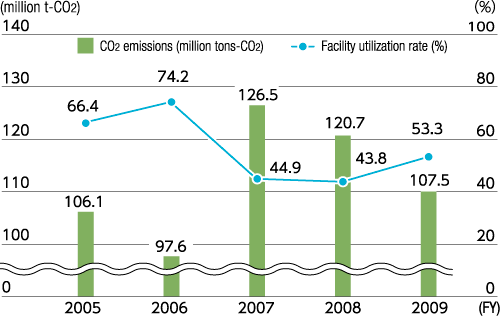
Nuclear facility utilization rates in major countries
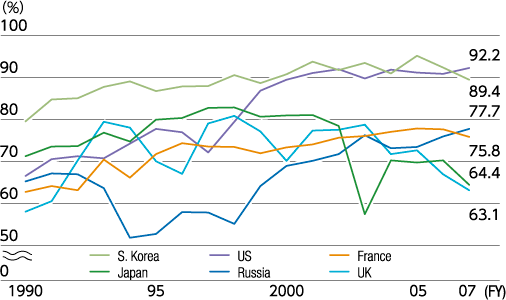 Source: Japan Nuclear Energy Safety Organization, “Operational Status of Nuclear Facilities in Japan” (2004 - 2009 editions)
Source: Japan Nuclear Energy Safety Organization, “Operational Status of Nuclear Facilities in Japan” (2004 - 2009 editions)
Thermal power generation is important to ensuring the stable supply of electricity, as it can respond flexibly to changes in power demand.
We strive to minimize CO2 emission from thermal power generation by promoting LNG-fired thermal power generation, which emits smaller amounts of CO2 compared to other types of thermal power generation, and also by making ongoing efforts to increase thermal power generation efficiency.
TEPCO has introduced a 1,500℃ combined-cycle power generation system (More Advanced Combined Cycle (MACC) system) which provides one of the world's highest thermal efficiency level of about 59%, to the Kawasaki Thermal Power Station in 2007 and to the Futtsu Thermal Power Station in 2008. Furthermore, we are currently conducting an environmental assessment* toward introduction of a 1,600℃ combined-cycle power generation system (MACC II system) that would realize a thermal efficiency of about 61%. Operation of the system is slated to commence in FY2016 at the Kawasaki Thermal Power Station and in FY2020 or beyond at the Goi Thermal Power Station. We are reducing about 1.9 million tons of CO2 emissions per year for every 1% increase in average thermal power generation efficiency.
* The MACC system at our Kawasaki Thermal Power Station was recognized for its significant effect in reducing CO2 from the entire lifecycle of products and technologies, and was selected as "Low-CO2 Kawasaki Pilot Brand 2009" by Kawasaki City in 2010.* Environmental assessment
The process of surveying, estimating, and assessing the possible impact of business activities on the environment. Assessment results are disclosed to the public to widely obtain the views of local residents and stakeholders.
TEPCO's thermal power generation efficiency (lower heating value)
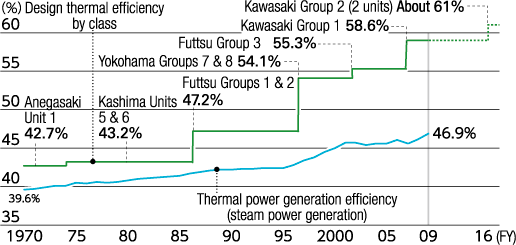 (Note) Lower heating values (LHV) were estimated from higher heating values (HHV), using the conversion coefficient from General Energy Statistics (FY2004).
(Note) Lower heating values (LHV) were estimated from higher heating values (HHV), using the conversion coefficient from General Energy Statistics (FY2004).
International comparison of thermal power generation efficiency
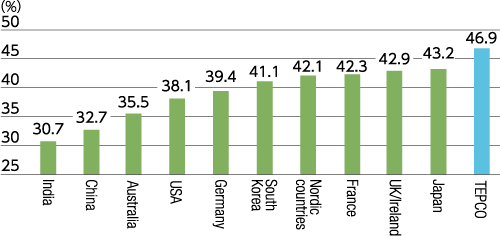 Source: ECOFYS, "INTERNATIONAL COMPARISON OF FOSSIL POWER EFFICIENCY AND CO2 INTENSITY"
(Notes) Thermal efficiency values represent weighted average thermal efficiencies of coal, oil, and gas on the power generating end (LHV standard).
Source: ECOFYS, "INTERNATIONAL COMPARISON OF FOSSIL POWER EFFICIENCY AND CO2 INTENSITY"
(Notes) Thermal efficiency values represent weighted average thermal efficiencies of coal, oil, and gas on the power generating end (LHV standard).
The thermal efficiency of independent power generation equipments is not included.
The figure for TEPCO is FY2009 result. Other figures are 2006 values. TEPCO’s result in FY2006 is 46.1%.
Technological innovation is essential to achieving significant CO2 reductions in the future. We are therefore focusing our efforts on developing new technologies that would help reduce CO2 emissions.
Coal is available in abundance from diverse sources, and is an important resource to Japan, as a country that is largely dependent on imports for energy resources. In order to take advantage of the benefit of coal, which enables stable and economical supply of electricity, and to reduce CO2 emissions significantly, TEPCO is addressing to develop an integrated coal gasification combined cycle (IGCC) system. When commercialized, the system is expected to provide a high thermal efficiency of 48-50% (LHV standard; transmitting end), while emitting only the same amount of CO2 as oil-fired thermal power generation. We are presently conducting a demonstration test toward commercialization of the technology. In verification tests performed in 2009, we attained our target power generation efficiency of more than 42%, and verified the feasibility of using few types of coal. We will be carrying out further investigations to make sure the commercial system would provide the required performance, endurance, and economic efficiency.
* IGCC
The system could provide high-efficiency power generation by means of a combined cycle that gasifies and burns coal.
CCS is globally regarded as an effective technology against global warming, and is being researched and developed all over the world.
For its part, TEPCO is conducting research and studies on CO2 recovery technologies using a small-scale test plant. We are also working to identify issues in CCS implementation, and have launched studies aimed at assessing the feasibility of a system that incorporates the CCS technology in power stations as a means of solving those issues.
* CCS
A process for capturing CO2 released from power stations and plants and storing it underground or in the sea for long-term isolation from the atmosphere.
CO2 separation/capture and underground storage technology
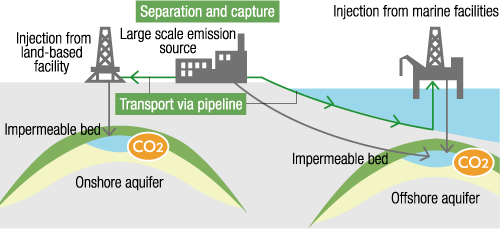 Source: Based on Ministry of Economy, Trade and Industry, "CCS2020"
Source: Based on Ministry of Economy, Trade and Industry, "CCS2020"
© Tokyo Electric Power Company Holdings, Inc.